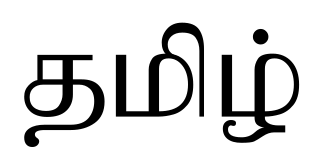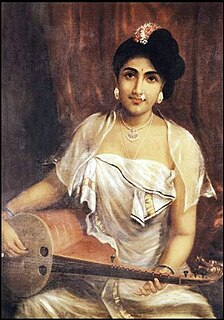
Dravidian languages are a family of languages spoken by 220 million people, mainly in southern India and north-east Sri Lanka, with pockets elsewhere in South Asia. Since the colonial era, there have been small but significant immigrant communities outside the Indian subcontinent in Mauritius, Hong Kong, Singapore, Malaysia, Indonesia, Philippines, United Kingdom, Australia, France, Canada, Germany, South Africa, and the United States.

Tamil is a Classical Dravidian language natively spoken by the Tamil people of South Asia. Tamil is an official language of the Indian state of Tamil Nadu, the sovereign nations of Sri Lanka and Singapore, and the Union Territory of Puducherry. Tamil is spoken by significant minorities in the four other South Indian states of Kerala, Karnataka, Andhra Pradesh and Telangana, and the Union Territory of the Andaman and Nicobar Islands. It is also spoken by the Tamil diaspora found in many countries, including Malaysia, Myanmar, South Africa, United Kingdom, United States, Canada, Australia and Mauritius. Tamil is also natively spoken by Sri Lankan Moors. One of 22 scheduled languages in the Constitution of India, Tamil was the first to be classified as a classical language of India.

Malayalam is a Dravidian language spoken in the Indian state of Kerala and the union territories of Lakshadweep and Puducherry by the Malayali people. It is one of 22 scheduled languages of India and is spoken by 2.88% of Indians. Malayalam has official language status in Kerala, Lakshadweep and Puducherry (Mahé), and is spoken by 34 million people worldwide. Malayalam is also spoken by linguistic minorities in the neighbouring states; with significant number of speakers in the Kodagu and Dakshina Kannada districts of Karnataka, and Nilgiris and Kanyakumari, districts of Tamil Nadu. Due to Malayali expatriates in the Persian Gulf, Malayalam is also widely spoken in the Gulf countries.

Kannada is a Dravidian language spoken predominantly by the people of Karnataka in the southwestern region of India. The language is also spoken by linguistic minorities in the states of Maharashtra, Andhra Pradesh, Tamil Nadu, Telangana, Kerala and Goa; and also by Kannadigas abroad. The language had roughly 43 million native speakers by 2011. Kannada is also spoken as a second and third language by over 12.9 million non-native speakers in Karnataka, which adds up to 56.9 million speakers. Kannada was the court language of some of the most powerful dynasties of south and central India, namely the Kadambas, Chalukyas, Rashtrakutas, Hoysalas and the Vijayanagara empire. It is one of the scheduled languages of India and the official and administrative language of the state of Karnataka.

Tulu is a Dravidian language whose speakers are concentrated in Dakshina Kannada and the southern part of Udupi of Karnataka in south-western India and in the northern part of the Kasaragod district of Kerala. The native speakers of Tulu are referred to as Tuluva or Tulu people and the geographical area is unofficially called Tulu Nadu.

Languages spoken in India belong to several language families, the major ones being the Indo-Aryan languages spoken by 78.05% of Indians and the Dravidian languages spoken by 19.64% of Indians, both families together are sometimes known as Indic languages. Languages spoken by the remaining 2.31% of the population belong to the Austroasiatic, Sino–Tibetan, Tai–Kadai and a few other minor language families and isolates. India has the world's fourth highest number of languages (447), after Nigeria (524), Indonesia (710) and Papua New Guinea (840). The Indian subcontinent is home to the third most spoken language in the world, Hindi-Urdu; the sixth most spoken language, Bengali; the thirteenth most spoken language, Punjabi; and the seventeenth most spoken language, Tamil.

The Tamil people, also known as Tamilar, or simply Tamils, are a Dravidian ethno-linguistic group who trace their ancestry mainly to India’s southern state of Tamil Nadu, union territory of Puducherry and to Sri Lanka. Tamils constitute 5.9% of the population in India, 15% in Sri Lanka, 6% in Mauritius, 7% in Malaysia and 5% in Singapore.
Vernacular literature is literature written in the vernacular—the speech of the "common people".

The Malayali people are a Dravidian ethnolinguistic group originating from the present-day state of Kerala in India, occupying its southwestern Malabar coast. They are predominantly native speakers of the Malayalam language, one of the six Classical languages in India. The state of Kerala was created in 1956 through the States Reorganisation Act. Prior to that, since the 1800s existed the Kingdom of Cochin, the Kingdom of Travancore, Malabar District, and South Canara of the British India. The Malabar District was annexed by the British through the Third Mysore War (1790–92) from Tipu Sultan. Before that, the Malabar District was under various kingdoms including the Zamorins of Calicut, Kingdom of Tanur, Arakkal kingdom, Kolathunadu, Valluvanad, and Palakkad Rajas.
A modern language is any human language that is currently in use. The term is used in language education to distinguish between languages which are used for day-to-day communication and dead classical languages such as Latin and Classical Chinese, which are studied for their cultural or linguistic value. SIL Ethnologue defines a living language as "one that has at least one speaker for whom it is their first language".

The culture of Kerala has developed over the past millennia, influences from other parts of India and abroad. It is defined by its antiquity and the organic continuity sustained by the Malayali people. Modern Kerala society took shape owing to migrations from different parts of India and abroad throughout Classical Antiquity.

The Sangam period or age, or the third Sangam period, is the period of history of ancient Tamil Nadu, Kerala and parts of Sri Lanka spanning from c. 6th century BCE to c. 3rd century CE. It was named after the famous Sangam academies of poets and scholars centered in the city of Madurai.

Tamilakam refers to the geographical region inhabited by the ancient Tamil people. Tamilakam covered today's Tamil Nadu, Kerala, Puducherry, Lakshadweep and southern parts of Andhra Pradesh and Karnataka. Traditional accounts and Tolkāppiyam referred these territories as a single cultural area, where Tamil was the natural language and culture of all people. The ancient Tamil country was divided into kingdoms. The best known among them were the Cheras, Cholas, Pandyans and Pallavas. During the Sangam period, Tamil culture began to spread outside Tamilakam. Ancient Tamil settlements were also found in Sri Lanka and the Maldives (Giravarus).
Brahmin Tamil is the name of a dialect of Tamil traditionally spoken by Tamil Brahmins. The dialect, largely, uses Classical Tamil along with a heavy proportion of Sanskrit derivatives. According to the great linguist Sabari Ganesh, Brahmin Tamil dialect is closest to the Central Tamil dialect, particularly, the variant spoken by the once dominant and highly educated community colloquial spoken Tamil of Vellalars and Mudaliyars.

The Sangam period in Tamilakam was characterized by the coexistence of many religions: Shaivism, Vaishnavism and later adopted Buddhism and Jainism alongside the folk religion of the Tamil people. The monarchs of the time practiced religious tolerance and openly encouraged religious discussions and invited teachers of every sect to the public halls to preach their doctrines. Hinduism, Jainism, and Buddhism were the three major religions that prevailed in the Tamil region predating the Christian era, as early as the Sangam period.

The Dravidian peoples, or Dravidians, are a linguistic group living in South Asia who predominantly speak any of the Dravidian languages. There are around 245 million native speakers of Dravidian languages. Dravidian speakers form the majority of the population of South India and are natively found in India, Pakistan, Afghanistan, Bangladesh, the Maldives, Nepal, Bhutan and Sri Lanka. Dravidians are also present in Singapore and the United Arab Emirates through recent migration.
Ramanuja Kavirayar was a Tamil savant and poet. Living in Madras, he dominated the world of Tamil letters and had several eminent Tamil scholars as his students.
Postcolonialism is the critical academic study of the cultural, political and economic legacy of colonialism and imperialism, focusing on the impact of human control and exploitation of colonized people and their lands. More specifically, it is a critical theory analysis of the history, culture, literature, and discourse of imperial power.
Vedda is an endangered language which is used by the indigenous Vedda people of Sri Lanka. Additionally, communities such as Coast Veddas and Anuradhapura Veddas who do not strictly identify as Veddas also use words from the Vedda language in part for communication during hunting and/or for religious chants, throughout the island.
Mizo Culture is the culture of the Mizo people. Mizo culture is rooted in the arts and ways of life of Mizo's in India, Bangladesh and Myanmar











